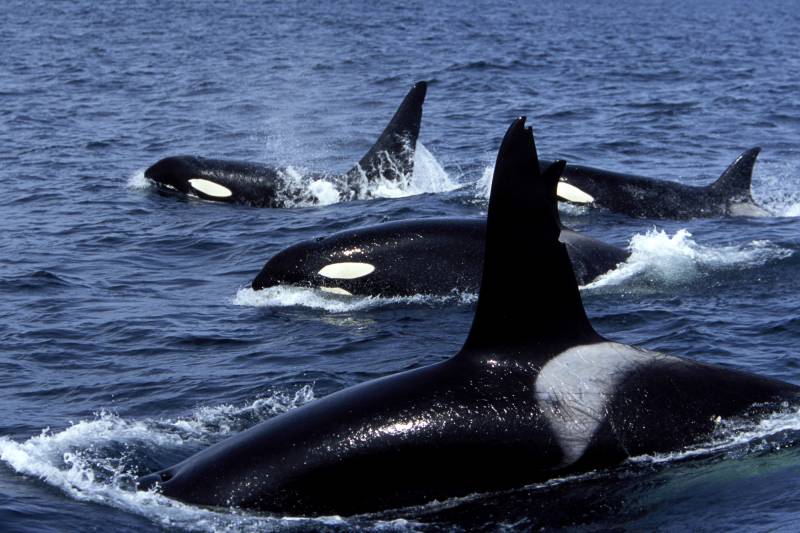So far, whale experts don’t think there’s a larger trend happening, although climate change has certainly affected gray whales’ ability to eat enough in Alaska — warmer waters are making the shrimp they dine on rare, and that’s caused a recent increase in gray whales dying during the trip. But the best explanation for all the orca activity near shore lately is it’s just been a great hunting period.
“It looks like they just had a really good season while the gray whales head north,” said Beth Scrutton with the Monterey Bay Aquarium.
When is whale-watching season?
“Whale-watching season on the California Coast is practically all year round, just different whales and different times of year,” said Scrutton. Mostly, we get humpback and gray whales. Sometimes, there are orcas or blue whales. “Recently, we’ve been seeing [whales] daily in Monterey,” she said.
Here are the best times to see the following whales:
Gray whales
Gray whales make a 12,000-mile round trip every year, summering in Alaska and then traveling to Mexico to winter off the coast of Baja, where they give birth in protected lagoons before heading back. They’re typically found around Monterey and the Bay Area from December to February, and then from April to May, although they’re not all on the same schedule.
Humpback whales
The humpback whales that winter in Mexico tend to spend their summers around here or in Oregon. Often, whole pods feed throughout the summer in Monterey Bay, and can be seen from April or May through October or November. Activity can be especially high in August and September, said Scrutton. “They’re the most acrobatic of whales we see,” she said.
Blue whales
The largest animal on earth, blue whales are also incredibly rare to spot. They tend to live in deeper waters, but feed off Monterey in the summer from June to October.
Orcas (aka killer whales)
While orcas are constantly on the move, ranging all up and down the West Coast, there is typically more activity around the Bay Area during the spring when gray whales are migrating, because that’s a good time to catch a calf for eating. However, because orcas constantly go where the food is, they don’t tend to spend more than a few days in one place — though they will travel and come back.
Where can I see whales in the Bay Area?
Unfortunately, it’s very rare to see orcas near San Francisco, even at this time of year, because of our shallow water. While humpback whales might occasionally come into the bay to feed, Black said she had never heard of orcas coming into the San Francisco Bay.
It’s also a math problem. There are, by Black’s estimate, about 120 killer whales that regularly frequent the waters off Monterey and the Bay Area. (One unique thing that likely contributed to recent sightings was a group of orcas that typically live in Canada traveling to become part of the large groups spotted here.) By comparison, there are about 5,000 humpback whales that make the migration. So your odds of seeing humpbacks are better.
Whale watching from shore
Your best bets from shore, said Pierson, are places with high vantage points, like near the lighthouses at Point Reyes or Point Bonita. Lands End, in the city, can be good, if you look out in the distance. Or go where deep water comes close to shore down at Point Lobos or near the Monterey Bay Aquarium. Still, it’s really just luck.
Whale watching from a boat
You’re much more likely to see whales if you head out to where they are.
Both Pierson and Black run whale-watching tours, with the Oceanic Society and Monterey Bay Whale Watch, respectively. In the Bay Area, the Oceanic Society goes out to the Farallons every Saturday and Sunday; right now, you can also see 300,000 to 500,000 birds during their nesting season. (San Francisco Whale Tours also takes boats out to the Farallons.)
How do the tours find whales? By looking for spouts or spray far off in the distance. Using smell on foggy days is another way to find them, said Pierson. It “smells like rotten broccoli and fish,” he said. “Once you smell it, you never forget the smell.”
Tell us: What else do you need information about?
At KQED News, we know that it can sometimes be hard to track down the answers to navigate life in the Bay Area in 2023. We’ve published clear, practical explainers and guides about COVID, how to cope with intense winter weather and how to exercise your right to protest safely.
So tell us: What do you need to know more about? Tell us, and you could see your question answered online or on social media. What you submit will make our reporting stronger, and help us decide what to cover here on our site, and on KQED Public Radio, too.
